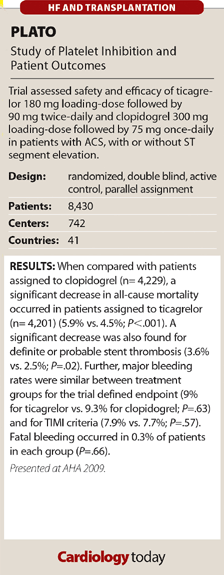PLATO: Ticagrelor decreased mortality from CV, MI, stroke in patients with STEMI
American Heart Association Scientific Sessions 2009
Treatment with ticagrelor significantly reduced mortality associated with CV, MI or stroke by one year — without similar rates for major bleeding — when compared with clopidogrel in patients with ST segment elevation or non-ST segment elevation ACS, according to new data from the PLATO trial.
“The overall reduction in mortality is important in the context of primary PCI because it is afforded on top of modern care in patients already undergoing PCI and who have received a stent. Therefore we believe that ticagrelor may become the new standard of care in patients with STEMI intended for primary PCI,” Philippe Gabriel Steg, MD, professor of cardiology and director of the coronary care unit at Hospital Bichat-Claude Bernard in Paris, France, said during a presentation. Steg is a consultant for AstraZeneca.
The researchers compared safety and efficacy of ticagrelor (Brilinta, AstraZeneca) and clopidogrel in patients with ACS, with or without ST segment elevation. Previous findings were presented at the European Society of Cardiology Congress 2009.
Patients were randomly assigned for one year to ticagrelor 180 mg loading-dose followed by 90 mg twice-daily (n= 4,201) or clopidogrel 300 mg loading-dose followed by 75 mg once-daily (n= 4,229).
All patients were assigned to 325 mg aspirin daily. An additional dose of ticagrelor was assigned at the time of randomization for patients who underwent PCI. Follow-up visits were at one, three, six, nine and 12 months.
STEMI was identified in 38% of patients, 43% were non-STEMI and 17% had unstable angina. Sixty-one percent of patients had PCI performed during the index hospitalization and 4.5% of patients had cardiac surgery. Overall, about 46% of patients were assigned to clopidogrel during hospitalization prior to randomization.
Mortality from vascular causes, MI or stroke at one year occurred less frequently in patients assigned to ticagrelor when compared with patients assigned to clopidogrel (9.8% vs. 11.7%; P<.001). This finding also occurred during 30 days of treatment and in patients with a planned invasive treatment (8.9% vs. 10.6%; P=.003).
When compared with patients assigned to clopidogrel, a significant decrease in all-cause mortality occurred in patients assigned to ticagrelor (5.9% vs. 4.5%; P<.001). A significant decrease was also found for definite or probable stent thrombosis (3.6% vs. 2.5%; P=.02).
Further, major bleeding rates were similar between treatment groups for the trial defined endpoint (9% for ticagrelor vs. 9.3% for clopidogrel; P=.63) and for TIMI criteria (7.9% vs. 7.7%; P=.57). Fatal bleeding occurred in 0.3% of patients in each group (P=.66). – by Jennifer Southall
For more information:
- Steg PG. #97. Presented at: the American Heart Association 2009 Annual Scientific Sessions; Nov. 14-18; Orlando, Fla.

![]()
The potential explanation of these findings are that ticagrelor provides a more comprehensive and consistent level of platelet inhibition without sacrificing an increased level of bleeding. A more rapid reversible characteristic may make this agent well suited for inhibiting platelet function under appropriate clinical conditions while reducing the risk of bleeding complications. However, the reversible receptor binding and a 12 hour half-life necessitate twice-daily dosing, which might be a challenge to patients who are not fully compliant.
– Lisa K. Jennings, PhD
Vascular Biology Center
University of Tennessee Health Science Center, Memphis

